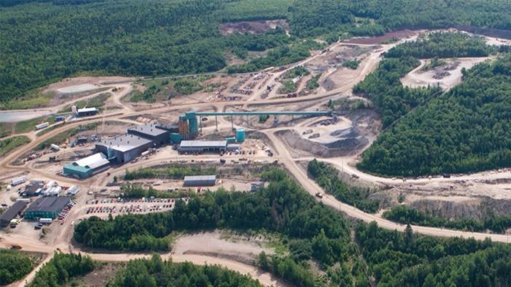
The Caribou mine, in New Brunswick
Photo by: Trevali Mining
VANCOUVER (miningweekly.com) – Zinc producer Trevali Mining has discovered a significant new body of massive sulphide mineralisation containing significant zinc-rich polymetallic intervals at the Caribou zinc mine, in the Bathurst Mining Camp of New Brunswick.
The additional mineralisation substantiates Trevali's decision to build another mill in the region or to sequence the added ore through the existing Caribou zinc mill to effectively extend the current mine life.
The TSX- and BVL-listed company announced the discovery on Monday, noting that the zone is centred about 350 m from the currently defined deposit and remains open for expansion.
In 2015, the first hole into the north limb extension was reported – BR-1014A intersected 50.9 m grading 5.08% zinc (Zn), 1.76% lead (Pb), 0.37% copper (Cu), 59.66 g/t (Ag) and 1.63 g/t gold (Au). The intercept was interpreted to highlight the excellent continuity of mineralisation along the prospective ‘Caribou Horizon’ and was a significant step out beyond the 2014 resource base.
Some of the most recent highlights cut in hole BR-1025 tested an area about 100 m up-dip from BR-1014A, and intersected 35.39 m at 4.28% Zn, 1.41% Pb, 0.38% Cu, 53.06 g/t Ag, 1.28 g/t Au, within which are higher-grade intercepts. Hole BR-1033 was planned to test the continuity of mineralisation about 100 m down-dip from the currently defined Caribou orebody, and intersected 11.98 m at 6.05% Zn, 2.23% Pb, 0.37% Cu, 80.91 g/t Ag, 2.12 g/t Au, including a 3.23 m intercept grading 7% Zn, 2.07% Pb, 0.65% Cu, 65.36 g/t Ag, 0.41 g/t Au.
Trevali advised that the 2017 exploration programme was designed to follow up and better define and expand this zone of mineralisation: Drilling to date has defined two lenses of massive sulphide mineralisation that vary from 5 m to more than 30 m thick and have a currently modelled strike length of about 450 m and a dip length of about 700 m, within which higher-grade run-of-mine mineralisation occurs, the company advised.
Mineralisation as currently defined is located next to mine infrastructure; it effectively doubles the strike length of the North Limb of the Caribou deposit and remains open for expansion.
The current 2017 inferred resource drilling programme is scheduled to be completed by mid-December, with further drill results and a resource estimate to be announced in the first quarter of 2018. Potential extensions to the East Limb remain to be tested in 2018.
Analysts expect that the forthcoming Caribou resource update will shed more light on whether Trevali will build another zinc mill in the region, which could hold equity re-rating potential. Trevali’s TSX-listed equity closed the day up 3.05% at C$1.35 a share.